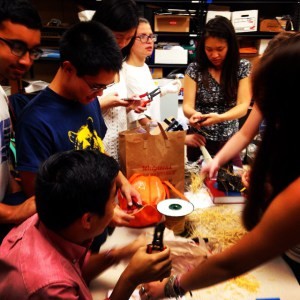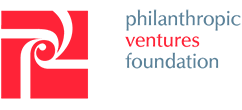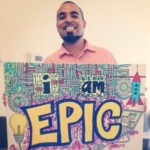Engineering Halloween Fun: An Interview with a Bay Area Inspire Award Grantee
by: Aly Quiroz-Perez
Recently, PVF awarded grants to six young Bay Area residents for coming up with fresh ideas for building better communities. These awards were made possible through theBay Area Inspire Awards, which provides $10,000 grants to 18-30 year olds living in San Francisco or Alameda Counties with an innovative, community-oriented idea.
PVF will introduce the 2014 Bay Area Inspire Awards winners in a series of blog posts to give you a sense of what these amazing individuals are doing to change their communities for the better.
PVF will begin the series with an interview with A.J. Almaguer. He is leading a project that provides young people with hands-on STEM experiences that will culminate in a haunted house event for the community. The haunted house, called “Escape from Dr. Ella Mental’s Laboratory,” is one of the attractions at the Town of Terror event hosted at Albany High School, which will take place on Saturday, October 25 from 12:00-8:00 p.m. For more information about Town of Terror click here.
PVF: What inspired you to become an engineer?
AA: I became an engineer kind of by accident. I applied to study mechanical engineering in college for two main reasons: 1) I really liked physics thanks to my awesome high school physics teacher, Ms. Lieux, and 2) I didn’t want to do pure science and I thought that engineering was all about applying science to build things – a generally accurate preconception.
PVF: What STEM programs were available to you as a student that allowed you to take your first steps in the field of engineering?
AA: The main STEM programs that were offered to me came through school. I didn’t know that
STEM programs existed outside of school. My college friends always talked about how we wished we had a mentor or one of these programs when we were growing up. I think this is quite common, actually.
I have to give credit to my mom for being an engineer. She went out of her way to transfer me to other schools in my hometown for their special programs. My elementary school was a science magnet school and my high school had the International Baccalaureate program. My mom is my main reason for going to Cal to study engineering because she advocated for my education and she put me in a high school where I was surrounded by high performing college-bound students.
PVF: What inspired you to start the Berkeley Engineers and Mentors (BEAM) program?
AA: I joined UC Berkeley’s Society of Hispanic Professional Engineers (SPHE) my freshman year and one of the volunteering opportunities was to do outreach to our community. We would bring high school kids to campus for a daylong introduction to engineering conference and visit schools on occasion.
However, I thought we could make a bigger impact by providing a consistent mentoring program rather than a one-day interaction with our community. So, I began a mentoring program out of our SPHE chapter. A year later, my friends and I realized that we were all running our own mentoring or outreach programs in our respective student organizations. So we decided to combine forces. We created a new organization and an accompanying DeCal (a student-run course) so that our mentors would receive credit for their work. That was how we created BEAM. By creating BEAM, we could actually spend time training the undergrads on how to be effective mentors and make sure that they could successfully build the engineering projects with their kids. Since graduating nearly four years ago, BEAM has taken a life of its own. I’m happy to have the chance to work with them again and that they’re grown up enough to take on this endeavor with me.
PVF: Why are you interested in creating change in your community?
AA: Like many of my peers who were also first generation college students, I felt very privileged to be at such a prestigious university, so I felt compelled to pay it forward. I think that’s why our SHPE chapter did outreach in the first place. The other reason is a little more selfish. I’m way more motivated to complete projects when there’s a teaching component involved. Doing work for my community is much more meaningful to me and it also allows me to practice engineering at a much faster pace. The product development cycle at a big corporation takes years! I was so bored in corporate America. I feel like working in the education world is like working in the ER. Everything is so fast! This haunted house is definitely being turned around at record speed. I consider myself a professional big kid at work. I live for creating those Wow! moments in people; those memorable experiences that stick with people for the rest of their lives.

BEAM mentors stripping wires so that their kids can build LED-lit ornaments for Dr Ella Mental’s Lab.
PVF: Can you tell us more about the students involved in this Haunted House project?
AA: There are three groups of students involved in this Haunted House project: TechHive Interns, the BEAM after school program, and Albany High School’s leadership class. The TechHive Interns comprise of 33 high school students. They work with me at our design studio at the Lawrence Hall of Science. Our goal is to give them an industry-like design internship experience. There are approximately 100 mentors in BEAM, all Cal students, who work with approximately 250 elementary and middle school students. BEAM partners with schools’ after school programs and offers a weekly mentoring session with kids who either sign up or are referred to the program. Every week the mentors come with a lesson plan on a science or engineering concept. There’s always a hands-on component to the lessons too. The BEAM kids are all building three projects for the Haunted House with the help of their mentors. They’re creating their own (decapitated) head in a jar, a LED-lit light ornament, and an animatronic bat that has 3D printed parts. The last group is the leadership students at Albany High. They’re being led by Ms. Mariflo Hudson and Assistant Principal Kevin Goines. They’ve split up into two groups and are the main reason why we’ve been able to turn our haunted house into the Town of Terror! One group is working with the TechHive to build the Haunted House. The other group is putting on the rest of the Town of Terror.
PVF: What is your hope with how this project will create change?
AA: I opened my grant proposal with a story about making toys with my nieces and nephews because I think those experiences mean so much to me. I think one of the best ways we could
teach our kids is to have them apprentice us. I personally like learning that way better than school and it is the type of experience that I am trying to provide to all my students.
I don’t believe we trust our kids enough. I don’t think we push them enough. And I think we dumb things down too much for them in school. While we’re giving our kids manageable tasks, I still maintain my professional engineering expectations. Through this whole process, I hope the kids realize that engineering projects can utilize the power of community to create good things for the community.
PVF: How have you prepared students to handle the challenges of building a haunted house?
AA: The reality is that the kids do have a limit in how much they can contribute to a project. However, I don’t believe that should limit the scope of the project. I want the kids to be proud that they were part of something amazing part of creating something that is larger than life! So we do lots of preparation to make sure that the kids have manageable tasks to accomplish. Some of the tasks are menial. However, many take a considerable amount of skill. Nonetheless, they’re all important in creating this project.
PVF: What would you like donors to know about funding community projects like yours?
AA: I actually don’t think there are many community projects like mine. This project does remind me of what Habitat for Humanity and of the old tradition of raising the barn. I wish that those types of projects were acknowledged more for providing real world engineering experience. I also wish that there were more of these technically complex community projects. Engineers need to step it up and lead in their community more.






